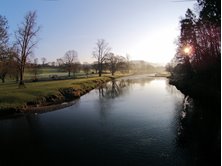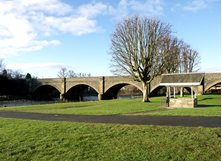The castle is located approximately 1km west of Peebles on the A72. The entrance is signposted and there is car parking on site. It is also readily accessible on foot as there is a footpath all the way. Viewing the castle from the riverside is also recommended (see 'riverside walks' for directions).
An early castle was probably founded here by Sir Gilbert Fraser around 1190. Fraser already owned Oliver and Fruid Castles on the upper reaches of the Tweed. He was followed by his son Sir Simon Fraser (died 1291) and Sir Simon the Second who was famed for defeating the English three times in one day at Rosslyn Moor in 1302. He was later captured and executed alongside Sir William Wallace in 1307.
Following his death, the barony of Neidpath passed to the Hay family, through marriage to Mary, the Fraser heiress.
Sir William Hay (d.c.1390) probably built the present castle in the late 14th century. Sir William Hay´s grandson, also Sir William (died 1421), married the daughter and heiress of Sir Hugh Gifford of Yester so acquiring Yester Castle, which then became the principal family seat. Even so, Neidpath continued to be used.
It was visited by Mary, Queen of Scots in 1563, and by her son James VI in 1587.
In 1646, John, Eighth Lord Hay of Yester, was created 1st Earl of Tweeddale by King Charles II. The castle was damaged during Oliver Cromwell's invasion of Scotland in 1650 and during the 1660s, the Second Earl of Tweeddale remodelled the castle, and constructed outbuidings and planted an avenue of yews, of which one side remains.
In 1686 the estate was bought by the first Duke of Queensberry and in 1693, Queensberry gave the castle to his second son William Douglas, later the First Earl of March. The Third Earl of March inherited the title and estates of the Duke of Queensberry in 1778, and subsequently let Neidpath to tenants.
These included the philosopher and historian Adam Fergusson, with whom Sir Walter Scott spoke to William Wordsworth of having spent cheerful days at Neidpath.
The Fourth Duke, William Douglas became one of the wealthiest landlords in the kingdom, but spent most of his days in London as the star of Piccadilly and was known as 'Old Q'. He cared nothing for his lands and in 1795, ruthlessly cut down many trees and demolished the beautiful hanging gardens that sloped down the castle banks to the Tweed. He was famously pilloried for this act by William Wordsworth in a sonnet written after his visit in 1803.
The castle suffered neglect and by 1790 the upper storeys of the wing had collapsed. On the death of the unmarried Fourth Duke in 1810, the castle, along with the earldom of March, was inherited by Francis Charteris, Sixth Earl of Wemyss, through his great-great-grandmother, Anna Douglas, only daughter of the First Duke of Queensberry and wife of David, Third Earl of Wemyss. The dukedom went to the Scotts of Buccleuch.
The Wemyss family have not resided in the castle, but continue to maintain it and improve it where possible.
The upper floors were remodelled in the 16th century, when the partially enclosed parapet was added. More alterations were carried out by the 2nd Earl of Tweeddale in the 17th century, when the ground floor was remodelled, a new stairway inserted and a sub-dividing floor was added below the vault of the hall.
The original entrance was in the re-entrant angle but was moved to the centre of the east wall. Both ground floor rooms are vaulted and there is a turnpike stair inside the south wall. The first floor has a room in the wing and a wide stair leading up to the hall on the second floor. Another turnpike in the north-west angle gives a third route for access to the upper levels. The third floor is also vaulted.
The carved keystone of the arched gateway displays the goat's head emblem of the Hay's, Earl's of Tweeddale.
It was garrisoned against Cromwell in 1650 and is reputed to have held out longer than any other stronghold south of the River Forth. A large section of the south wall and part of the upper level's were badly damaged during the siege. This is still visible today.
The main block was rebuilt soon after, and the parapet partially re-roofed to form galleries with square turrets adding a garret storey The original roof was flat.









